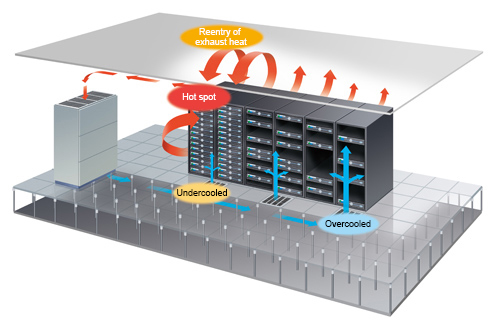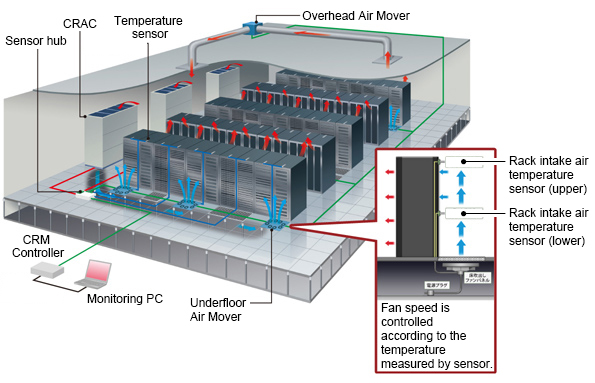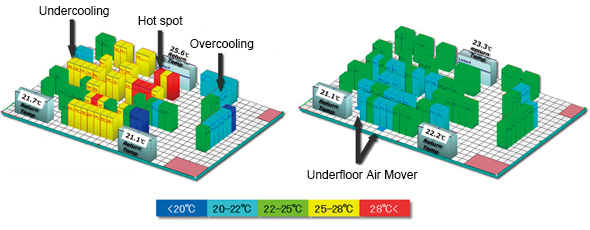Data center environment solutions ensuring energy-efficiency and reliable operation
Airflow management solution for data center environments
The primary roles of a data center are to operate IT equipment such as servers, storage devices, and communications equipment safely and reliably, and to provide operational services for customers. To ensure reliable and safety operation, emergency power generators and security system, etc., are installed in earthquake-resistant buildings. The temperature should be well maintained, with computer room air conditioners (CRACs) and airflow comprehensively and continuously managed so that cold air is reliably supplied to the IT equipment. Azbil Corporation offers an airflow management solution for data center environments that provides both redundancy and energy conservation.
Background and Needs
CRAC units maintaining a consistent environment for IT equipment
CRAC units play a key role in assuring uninterrupted uptime of IT equipment. If CRACs don’t operate appropriately, the temperature may exceed the thermal range[*1] due to the heat generated by IT equipment. This will degrade the reliability of the equipment and, in a worst-case scenario, lead to the system going down.
Such a critical failure at the data center would force companies to interrupt their business, and lead major losses. In order to prevent a critical failure, some data centers overcool their entire space to accommodate hot spots. This causes increasing their energy costs. The following functions and characteristics are desirable for CRACs.
- Elimination of hot spots, reentry of exhaust heat, and unbalanced airflow due to excessive cooling, so that cold air at right temperature is supplied to all IT devices.
- Ability to adapt to increased or decreased IT load
- Sufficient redundancy and flexibility to maintain the server room environment when an incident such as a CRAC failure occurs.
- In addition to satisfying the above points and operating reliably, cooling units are required energy savings, and reduction of the operation cost and CO2 emission by eliminating excessive cooling.
To meet these requirements, Azbil Corporation offers an airflow management solution that controls data center airflow comprehensively and appropriately, constantly maintaining the most suitable temperature and environment for IT equipment while providing redundancy and energy conservation.
Problems for data center air conditioning

Airflow can be disturbed by pillars, beams, racks, and other obstructions, causing hot spots and excessive cooling.
[*1] The American Society of Heating, Refrigerating & Air Conditioning Engineers (ASHRAE) recommends an intake air temperature of 18–27℃ for data center equipment, with 10–35℃ as allowable.
Key Innovations
Airflow management with sensing technology and "visualization" by means of computational fluid dynamic analysis
The basic concept behind Azbil’s airflow management solution is demand-based cooling, in which the required amount of cold air is supplied to the necessary place according to the amount of heat generated by the equipment.
First, the thermal environment of the server room is examined. Using computational fluid dynamic (CFD) analysis, the airflow and heat distribution in the server room is visualized. A variety of “What if” scenarios, such as CRAC failures, can then be simulated, so that the measures necessary for optimizing the airflow can be taken.
Next, based on the measures determined to be necessary, underfloor air mover, overhead air mover, etc., are installed to eliminate problems like hot spots and excessive cooling. The next step is to control CRACs, underfloor air mover, and other such equipment on the basis of sensing data from temperature sensors installed in key locations. The CRAC supplies cold air not only to its defined zone, but also can flexibly cover the area between zones in order to achieve efficient and uniform airflow distribution. All racks and IT devices can be received enough air for their stable operation.
Furthermore, if significant changes to room layout or IT load occurs, the airflow zones and control method are reevaluated, in close consultation with the data center administrator, in order to continuously maintain a consistent environment.
Drawing upon its expertise in thermal and airflow analysis, thorough understanding of the various characteristics of equipment, such as IT equipment, and CRACs, electrical equipment and achievements and experience in this field, Azbil Corporation provides reliable and safe cooling.
Airflow management solution

By controlling the underfloor and overhead air movers and CRAC operation, this solution ensures good data center thermal health through continuous monitoring of the intake air temperature of servers and the status of cooling units
Results and Future Outlook
Stabilization of the server room environment, plus redundancy and energy conservation Remarkable effectiveness demonstrated at numerous installation sites
Azbil’s airfow management solution achieves cooling efficiency and uniformity, providing operating environment stability for IT equipment, along with ensuring redundancy and the benefits of energy efficiency. It has been installed at tens of sites, including Azbil Corporation's own data center, and has shown remarkable effectiveness.
In an example from the Tokyo metropolitan area, after optimization of airflow distribution and installation of equipment such as underfloor air mover at a telecommunications company data center, hot spots were eliminated and consistent cooling was achieved. In addition, it was possible to shut down a number of CRAC, successfully reducing operation costs (the surplus CRACs are kept on hand as backup). Also, reliable operation is now made possible by real-time monitoring of temperature sensing data.
The thermal environment at a data center is an ever changing. In the past, there was no solution that could continuously cope with such changes.
But since Azbil's airflow management solution, uses CFD analysis to provide simulations of airflow and thermal distribution, scenario analysis, equalization of cooling by flexible supply of cold air between zones, and continuous support for short-term or long-term fluctuation in heat generation due to added or removed IT equipment, uninterrupted operation of the data center can be achieved.
Before (left) and after (right) results using the airflow management solution

In the past there were 29 °C hot spots, exceeding the recommended temperature range. Installation of Azbil’s airflow management solution provided uniform cooling and reduced the number of operating CRACs.
*Handling of products and services described in “azbil techne” may differ by country or region.
